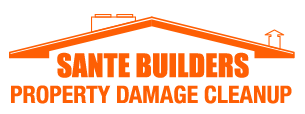How to Identify a Hazardous Tree
Many properties have the benefits and risks of trees and wooded areas. Trees add beauty, shade, and value. How do you identify a hazardous tree? Under the law, it is your duty to exercise care, good judgment, caution, and foresight by inspecting your trees regularly and recognizing situations that may cause them to break or fall. It is an important part of care-taking of any property.
There are many signs that a tree is a fall hazard. You just have to know where to look and what to see. Simple annual examinations of every tree on your property can prevent and identify tree hazards. Think you can’t? Call in a licensed general contractor like Sante Property Reconstruction to handle your landscaping tree services. Doing it on your own? Check out our expert tree hazard tips below.
Check For Brittle Tree Species
Hazardous trees present risks. Brittle species like willows, box elders, and silver maple are more likely to fall and cause damage. Plant these trees only in open areas. If they already exist on your property, avoid creating seating or play areas in their potential fall reach. You can eliminate the need for concern by careful landscape planning.
Consider The Tree’s Risk History
Find out as much as you can about every tree on your property. This will lead to preventing and identifying tree hazards in the future. For example, trees that have been topped will likely have weakly attached regrowth. If you see broken branches with stubs not pruned, or sprout-like regrowth after storm damage, you’re looking a potential problem. And an unexplained loss of large limbs may also be a sign that the tree is a hazard.
Evaluate The Health Of The Tree
It’s not as hard as you think to evaluate the health of trees. Signs of health and vigor in a tree include a large amount of leaf cover, good-sized leaves, and leaves rich in color and in good condition. If you’re still not sure, try comparing the questionable tree with others of the same species and of like size. Tree falling hazards can easily be foreseen with simple examinations.
Look For Tree Branches That Cross or Rub
Tree branches that cross or rub lead to weak spots. Pruned these off as soon as you spot them. The smaller the crossed or rubbing branches are, the easier it is to eliminate them and positively impact the tree’s health. This simple examination will allow you to determine a tree’s fall risk, too. These branches will be the most likely to break and fall or becoming windblown during storm damage. Storm damaged trees are never safe.
Look For Dead Branches
Dead branches signal a tree falling risk. Loggers call these “widowmakers” and treat them with great respect. Homeowners and business owners should do likewise. Ensure your personal safety by having dead branches properly removed to prevent a branch from falling. Storms can quickly turn that dead branch into a major problem.
Remove Dead Trees
Dead trees anywhere near your home, business, or where people travel should be promptly removed. They certainly are tree hazards. But felling a large tree is dangerous. Always call in an expert. Dead trees are a hazard and will fall at some point. Their condition can also be spreadable and could damage other trees on the property. This will prevent more trees from falling.
Preventing Future Tree Hazards
Once you’ve identified and dealt with any existing tree hazards, how do you prevent more falling risk in the future? The Tree City USA Bulletin has some answers here, too:
• Inspect your trees carefully a few times a year. Have a qualified arborist inspect them annually and provide you with a written report.
• Don’t plant brittle fall risk trees where falling limbs could injure people or property. Some brittle tree species are: Silver maple, Lombardy poplar, box elder, and willows.
• Prune your trees regularly. Use correct pruning methods including pruning outside the branch collar. Do not top your trees.
• Plant the right tree in the right place. One example is not planting large-growth trees under power lines or too close to your home’s foundation.
• Make sure the trees selected are a good match for the type of soil and other characteristics of your site.
• Water deeply during dry periods. Slowly apply one inch or more of water.
• Consider cabling or bracing weak forks or branches in older trees of high value.
• Don’t plant hazardous trees with narrowly-forked stems.
• If you have a high value tree you think may become a hazard, use landscaping to keep people at a safe distance. Some techniques that work include re-routing walks, moving patio furniture, and planting shrubs and hedges as barriers to foot traffic.
Healthy, vigorous trees add beauty, shade, and value to your property. Give them regular care and they’re less likely to become tree hazards. Prevention is the best solution to any tree hazard concern.
Tree damage? Tree hazards? Sante Property Damage Reconstruction is always available to help before or after a tree has fallen. Feel free to call us anytime at (844) 254-1480.
More Resources:
General Contracting and Landscape Services
Sante Property Damage Reconstruction
100 Peters Road
Suite B
Bloomfield, CT 06002
Call (844) 254-1480
Business Hours: 24/7
Quick Links
Location
Contact Information
Sante Damage Reconstruction
100 Peters Road
#B
Bloomfield, CT 06002
Phone: (860) 216-2784
Business Hours: 24/7
CT Contractor License: 0609599
Certifications


